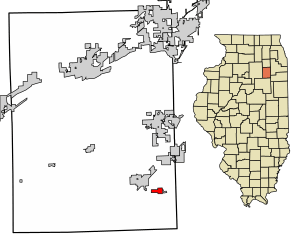South Wilmington, Illinois facts for kids
Quick facts for kids
South Wilmington
|
|
|---|---|

Location of South Wilmington in Grundy County, Illinois.
|
|

Location of Illinois in the United States
|
|
| Country | United States |
| State | Illinois |
| County | Grundy |
| Area | |
| • Total | 0.49 sq mi (1.27 km2) |
| • Land | 0.49 sq mi (1.27 km2) |
| • Water | 0.00 sq mi (0.00 km2) |
| Elevation | 587 ft (179 m) |
| Population
(2020)
|
|
| • Total | 710 |
| • Density | 1,443.09/sq mi (557.29/km2) |
| Time zone | UTC-6 (CST) |
| • Summer (DST) | UTC-5 (CDT) |
| ZIP Code(s) |
60474
|
| Area codes | 815 and 779 |
| FIPS code | 17-71370 |
| GNIS feature ID | 2399862 |
| Wikimedia Commons | South Wilmington, Illinois |
South Wilmington is a village located in Grundy County, Illinois, in the United States. In 2020, the population of the village was 710 people.
Even though its name sounds like it's close to the city of Wilmington, South Wilmington is actually about 11 miles southwest. Several other towns like Gardner, Braceville, Godley, and Braidwood are between them.
Contents
History of South Wilmington
South Wilmington officially became a village on August 23, 1900. Before that, the first election for village leaders happened on September 10, 1899. The first people chosen to lead the village were Robert McXulty, St. as president, Mike Finn as clerk, and Walter Ferguson as treasurer.
The very first family to live in South Wilmington was Mr. Gibson Simpson's family. They moved into a house that was brought from Braidwood. The second family was Patrick Corrigan's. He came to manage the first hotel in South Wilmington, which was built by the C. W. and C. Coal Company. In 1899, the coal company started building new houses and selling them to their workers. Many houses were also moved in from nearby towns.
Early Education in South Wilmington
In the fall of 1899, citizens held a meeting to raise money for a school. They wanted to help the few children living there. School started that same fall in an old store building on Third Avenue. Miss Carrie Peart was the first teacher. Miners paid a small fee each week to help run the school and pay Miss Peart.
People gave so much money that by the fall of 1900, a four-room schoolhouse was ready in District 74. In May 1902, four more rooms were added to the school.
First Religious Services
The first religious services in South Wilmington were held by the Baptist Sunday School in the fall of 1900. These services took place in a building called the Prophet Building, which was moved from Gardner. Rev. J. Blodgett and John C. Wilson helped start it, and F. E. Floyd was the first leader.
Later, in 1901, a church building was moved from Braceville for the Baptist services. Rev. J. Blodgett became the first pastor. The church was its own separate church for a short time. Then, it became part of the Gardner church until February 6, 1910, when it became a separate church again.
Notable Residents
Louis Bottino (1907–1979), who was an Illinois state representative and a teacher, was born in South Wilmington in 1907.
Geography
South Wilmington covers a total area of about 0.49 square miles (1.27 square kilometers). All of this area is land.
Population and People
| Historical population | |||
|---|---|---|---|
| Census | Pop. | %± | |
| 1900 | 711 | — | |
| 1910 | 2,403 | 238.0% | |
| 1920 | 1,362 | −43.3% | |
| 1930 | 722 | −47.0% | |
| 1940 | 642 | −11.1% | |
| 1950 | 662 | 3.1% | |
| 1960 | 730 | 10.3% | |
| 1970 | 725 | −0.7% | |
| 1980 | 747 | 3.0% | |
| 1990 | 698 | −6.6% | |
| 2000 | 621 | −11.0% | |
| 2010 | 681 | 9.7% | |
| 2020 | 710 | 4.3% | |
| U.S. Decennial Census | |||
According to the 2020 census, there were 710 people living in South Wilmington. There were 297 households and 186 families. This means there were about 1,443 people per square mile.
Most of the people living in the village (95.49%) were White. About 4.23% of the population identified as Hispanic or Latino.
Out of the 297 households, about 24.6% had children under 18 living with them. More than half (53.20%) were married couples living together. About 13.80% of households had someone living alone who was 65 years old or older.
The average age of people in the village was 35.7 years. About 25.8% of the population was under 18 years old.
The median income for a household in the village was $75,156. The median income for a family was $90,833. This means half of the households earned more than this amount, and half earned less. About 7.3% of all people in the village lived below the poverty line. This included 9.4% of those under 18 and 8.2% of those 65 or older.
See also
 In Spanish: South Wilmington (Illinois) para niños
In Spanish: South Wilmington (Illinois) para niños

